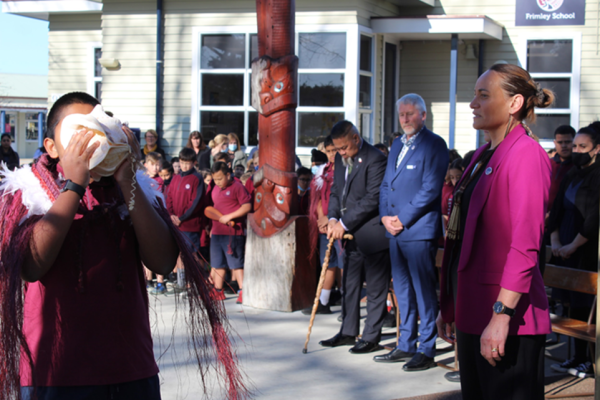Te Reo Māori at Frimley School
7 September 2022
For many in the teaching profession, the journey to grow and develop their capability and understanding of te reo me nga tikanga Māori has been an ongoing, challenging and rewarding commitment. Ngā Tikanga Matatika, Ngā Paerewa | Our Code, Our Standards sets out what it means to be a teacher in Aotearoa New Zealand. Matatu Aotearoa | Teaching Council New Zealand is wanting to use this month to shine a light on their efforts, on their motivations to support their own practice in their respective settings as they give effect to Te Tiriti in their schools, centres, and kura.
The work of Ngahina Transom, Deputy Principal at Frimley School, Hastings is an example of teachers striving for their learners, and themselves, on their journey in te reo.
Frimley School, decile 4, has about 600 ākonga in a diverse student roll, with about 43 per cent Māori, eight per cent Pasifika, 18 per cent Indian and about 30 per cent Pākehā.
Ina kei te mohio koe ko wai koe, I anga koe I hea, kei te mohio koe, kei te anga atu ki hea | If you know who you are and where you are from, then you know where you are going.
Deputy principal, Ngahina Transom, describes her te reo me ōna tīkanga journey as a lifelong, love-hate relationship. The whakatauki above motivates and inspires her to continue her personal and professional commitment to ensure that these tāonga tuku iho thrive in Aotearoa New Zealand.
 Te timatatanga o te powhiri i raro i te korowai o to mātou pou Te Wao Tapu Nui. Ko Natish te kaipumoana. Ko Hawira Hape te kaumatua whakaruruhau, ko Tim White te tumuaki, ko Ngahina Transom te kaikaranga.
Te timatatanga o te powhiri i raro i te korowai o to mātou pou Te Wao Tapu Nui. Ko Natish te kaipumoana. Ko Hawira Hape te kaumatua whakaruruhau, ko Tim White te tumuaki, ko Ngahina Transom te kaikaranga.
Frimley’s curriculum is based on a relationship with mana-whenua, where the school ensures that tamariki know, understand, and experience learning that is rich, authentic and relevant to past and present.
The following tauparapara lays the foundation for the school’s place-based curriculum which is conceptualised through the Ngāti Kahungunu pēpeha;
Heretaunga ararau, Heretaunga hauku nui, Heretaunga raorao haumako,
Heretaunga Haaro o te kaahu, Heretaunga Takoto noa
Ko Takitimu te waka, Ko Ngaruroro te awa, Ko Kahuranaki te maunga,
Ko Ngāti Kahungunu te iwi.
Ngahina explains that the school’s expectation is that te reo is integrated and woven into all learning and that everyone in the kura is a learner. Te reo has been a professional expectation since 2018. All of Frimley’s kaiako and kaiawhina set goals, have weekly internal lessons, and have defined expectations in their roles and responsibilities to uphold in the kura.
“We are all participating in Te Toka Tūroa, through Te Ahu o te Reo, delivered by Kauwaka who provides us the professional learning development that continually challenges us to uphold the mana of our kaupapa."
Ngahina sees her role in leadership as one that is to ensure that practises are culturally safe and that at the beginning of any decision, stakeholders are always included alongside the school’s staff. She says that “By practising our tīkanga as the “normal” way we do things here at our kura, provides a learning experience for all those present, to share in, not only what we are seeing, but what we are feeling and hearing.”
Ngahina and her colleague’s mahi was recognised when Frimley School became the 2021 Supreme Winner - Prime Ministers Award focussing on excellence in Engaging, Leading, Teaching & Learning, Wellbeing Education. Judges for the award said that there was an overall sense of community at Frimley Primary School. Teachers were united about the kaupapa in learning and enhancing students’ skills in te reo. Teachers had professional development on the marae, went on hikoi to learn about the area and are all learning te reo.
